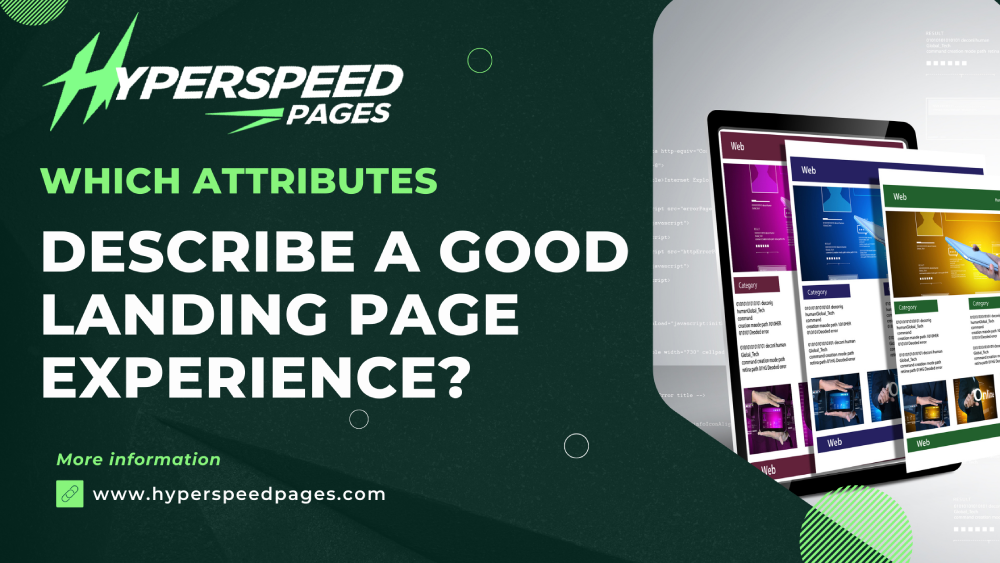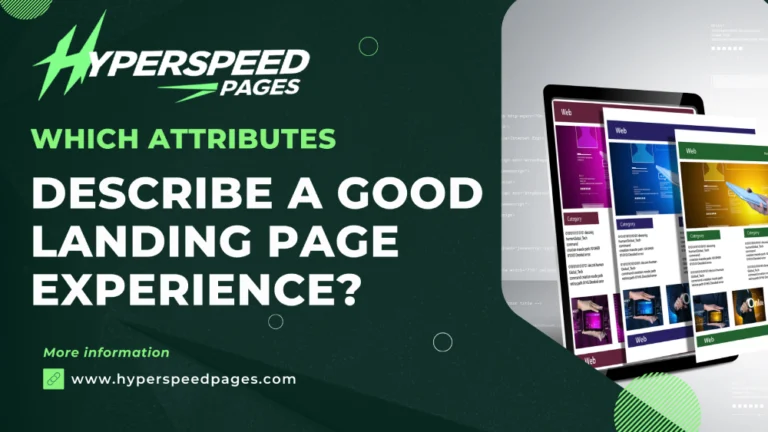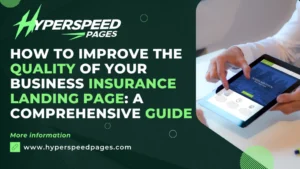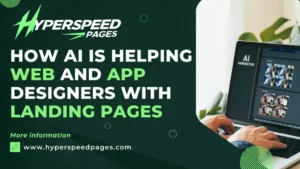
Creating an effective landing page is a critical component of digital marketing. A well-designed landing page not only attracts visitors but also converts them into leads or customers. To achieve this, it’s essential to focus on user experience (UX) design. Let’s explore the attributes of a good landing page user experience and how they contribute to higher conversion rates.
Understanding User Experience (UX) in Landing Pages
User experience refers to the overall experience a user has when interacting with a website or application. For a web landing page, UX is crucial because it directly impacts how visitors perceive your brand and whether they take the desired action. A good UX ensures that users can easily navigate the page, understand the message, and complete the intended action without friction.
Key Attributes of a Good Landing Page User Experience
1. Clear and Compelling Headline
The headline is the first thing visitors see when they land on your page. It should be clear, compelling, and immediately convey the value proposition. A strong headline grabs attention and encourages users to stay on the page. To achieve this:
● Use concise language that communicates the main benefit.
● Align the headline with the ad or link that brought users to the page.
● Make it visually prominent with a larger font size and contrasting colors.
2. Engaging Visuals
Visuals play a significant role in capturing attention and conveying information quickly. High-quality images, videos, or graphics can enhance the user experience by making the page more engaging and easier to understand. When selecting visuals:
● Ensure they are relevant to the product or service being offered.
● Use professional, high-resolution images that enhance your brand image.
● Consider using explainer videos to convey complex information succinctly.
3. Concise and Persuasive Content
Content should be concise, focused, and persuasive. Visitors typically skim landing pages, so it’s essential to communicate your message effectively with minimal text. To optimize content:
● Highlight key benefits and features using bullet points or short paragraphs.
● Use persuasive language that appeals to the emotions and needs of the target audience.
● Include testimonials or social proof to build trust and credibility.
4. Strong Call-to-Action (CTA)
The call-to-action is the most critical element of a landing page. It guides users toward the desired action, whether it’s signing up for a newsletter, downloading a resource, or making a purchase. To create an effective CTA:
● Use action-oriented language that clearly states what users need to do.
● Make the CTA button visually prominent with a contrasting color and larger size.
● Position the CTA strategically, ensuring it is visible without scrolling.
5. Fast Loading Speed
Page loading speed is a crucial factor in user experience and search engine optimization (SEO). Slow-loading pages can lead to higher bounce rates and lost conversions. To improve loading speed:
● Optimize images and videos to reduce file size without compromising quality.
● Minimize the use of heavy scripts and third-party plugins.
● Use a reliable hosting service that ensures fast server response times.
6. Responsive Design
With the increasing use of mobile devices, responsive design is essential for a positive user experience. A responsive landing page automatically adjusts its layout and elements to fit different screen sizes, ensuring usability across devices. To achieve responsiveness:
● Use a flexible grid layout that adapts to various screen sizes.
● Ensure buttons and links are easily clickable on smaller screens.
● Test the landing page on different devices to ensure consistent functionality.
7. Intuitive Navigation
While landing pages typically have limited navigation options to minimize distractions, any included navigation should be intuitive and user-friendly. Clear navigation helps users find information quickly and enhances their experience. To improve navigation:
● Use a simple menu or breadcrumb trail if necessary.
● Ensure links are clearly labeled and lead to relevant information.
● Avoid excessive navigation elements that may distract from the main CTA.
8. Trust Signals
Trust signals are elements that reassure visitors about the credibility and security of your page. They can significantly impact conversion rates by reducing user anxiety and building confidence. Effective trust signals include:
● Displaying security badges or SSL certificates for data protection.
● Including customer reviews, ratings, or testimonials.
● Showcasing recognizable brand logos or partnerships.
9. A/B Testing and Optimization
Continuous testing and optimization are essential for maintaining a high-performing landing page. A/B testing involves creating multiple versions of a page to determine which elements perform best. To optimize your landing page:
● Test different headlines, images, and CTAs to identify what resonates with users.
● Analyze user behavior using heatmaps and analytics to identify areas for improvement.
● Continuously refine the page based on data-driven insights.
10. Clear Value Proposition
Your landing page should clearly communicate the unique value proposition (UVP) of your product or service. The UVP explains why users should choose your offering over competitors and what benefits they will gain. To articulate a strong UVP:
● Focus on the key differentiators that set your product apart.
● Use clear and concise language to convey the value.
● Highlight the benefits and outcomes users can expect.
Landing Page Technicalities for an Amazing User Experience and Flow
The Importance of User Experience (UX) in Landing Pages
Before diving deep into the technical features, it’s important to understand why user experience is crucial for landing pages. A positive UX ensures that visitors can easily navigate the page, understand the value proposition, and complete the intended action without friction. This not only boosts conversion rates but also strengthens brand credibility and trust.
Technical Features That Enhance User Experience
1. Responsive Web Design
A responsive landing page automatically adjusts its layout and elements to fit different screen sizes, ensuring usability across desktops, tablets, and smartphones. Key aspects of responsive design include:
● Fluid Grids: Use a flexible grid system that adapts to various screen sizes, allowing content to flow seamlessly and maintain a consistent appearance.
● Flexible Images: Optimize images to scale correctly across devices without losing quality or causing slow loading times.
● Media Queries: Implement CSS media queries to apply specific styles based on the device’s characteristics, such as screen width and resolution.
2. Advanced CSS Animations and Transitions
CSS animations and transitions can enhance user engagement by adding visual interest and guiding users’ attention. When used judiciously, they create a dynamic experience that feels intuitive and engaging. Techniques to consider:
● Smooth Transitions: Use CSS transitions to provide visual feedback for user interactions, such as button hovers and form inputs, enhancing interactivity.
● Keyframe Animations: Create complex animations using CSS keyframes to animate elements like text, images, and buttons, making the page feel more interactive and alive.
● Loading Animations: Implement loading animations to keep users engaged during data retrieval processes, ensuring a seamless experience even when the page takes a moment to load.
3. Progressive Web Apps (PWAs)
Transforming a landing page into a Progressive Web App (PWA) can enhance user experience by providing app-like functionality. PWAs offer benefits such as fast loading times, offline access, and push notifications. Key features of PWAs include:
● Service Workers: Utilize service workers to cache assets and enable offline functionality, ensuring a consistent experience regardless of network conditions.
● Web App Manifest: Define a web app manifest to provide metadata about the PWA, including icons, start URL, and display mode, enabling users to install the app on their devices.
● Push Notifications: Implement push notifications to re-engage users and keep them informed about updates, offers, and promotions.
4. Optimized Loading Speed
Loading speed is a critical factor in user experience and search engine optimization (SEO). Slow-loading pages can lead to high bounce rates and lost conversions. Techniques to optimize loading speed include:
● Lazy Loading: Implement lazy loading for images and videos to defer loading until they are visible in the viewport, reducing initial load time and conserving bandwidth.
● Minification and Compression: Minify CSS, JavaScript, and HTML files to reduce file size, and use compression techniques like Gzip to further decrease the amount of data transferred.
● Content Delivery Networks (CDNs): Utilize CDNs to distribute content across multiple servers, reducing latency and ensuring faster loading times for users across different geographical locations.
5. Interactive Elements and Microinteractions
Interactive elements and microinteractions create a more engaging and intuitive user experience by providing feedback and enhancing interactivity. Examples include:
● Interactive Forms: Use real-time validation and error messages to guide users through form submissions, reducing errors and increasing conversion rates.
● Hover Effects: Implement hover effects on buttons, images, and links to provide visual feedback and enhance interactivity.
● Microinteractions: Incorporate subtle animations and interactions for tasks like toggling switches, liking posts, and submitting forms, creating a more engaging experience.
6. Secure and Trustworthy Features
Security and trust are paramount for any landing page, especially when handling user data. Implementing secure and trustworthy features builds credibility and encourages users to take action. Key considerations include:
● SSL Encryption: Ensure the landing page is secured with SSL encryption, indicated by the “https” protocol and a padlock icon in the browser’s address bar.
● Data Privacy Compliance: Adhere to data privacy regulations such as GDPR and CCPA by providing clear privacy policies and obtaining user consent for data collection.
● Trust Signals: Display trust signals such as security badges, customer testimonials, and recognizable brand logos to build credibility and reassure users of your legitimacy.
7. Dynamic Personalization
Dynamic personalization tailors the digital marketing landing page experience based on user data, preferences, and behavior, increasing relevance and engagement. Techniques for dynamic personalization include:
● Dynamic Content: Use dynamic content to display personalized messages, product recommendations, and offers based on user behavior and demographics.
● Geolocation Targeting: Implement geolocation targeting to provide location-specific content, offers, and information, enhancing relevance and engagement.
● Behavioral Triggers: Utilize behavioral triggers to deliver personalized experiences based on user actions, such as displaying exit-intent pop-ups to retain users who are about to leave the page.
8. A/B Testing and Analytics
Continuous testing and analysis are essential for optimizing landing page performance. A/B testing allows you to compare different versions of a page to determine which elements perform best. Key strategies include:
● A/B Testing Tools: Use A/B testing tools to experiment with different headlines, images, CTAs, and layouts, identifying the most effective combinations.
● Heatmaps and Click Tracking: Utilize heatmaps and click tracking to analyze user behavior and identify areas for improvement, such as optimizing placement of key elements.
● Conversion Tracking: Implement conversion tracking to measure the effectiveness of your landing page and identify areas for optimization.
9. Voice Search Optimization
With the rise of voice-activated devices, optimizing your landing page for voice search can enhance user experience and increase visibility. Techniques for voice search optimization include:
● Natural Language Content: Create content that aligns with natural language patterns, addressing user queries in a conversational tone.
● Structured Data Markup: Implement structured data markup to provide search engines with context and improve the chances of appearing in voice search results.
● Featured Snippets: Optimize content for featured snippets by providing concise and informative answers to common questions, increasing the likelihood of being selected as a voice search result.
10. Accessibility Compliance
Ensuring your landing page is accessible to all users, including those with disabilities, is crucial for a positive user experience and compliance with legal requirements. Key accessibility features include:
● Semantic HTML: Use semantic HTML elements to provide structure and meaning to content, enhancing screen reader compatibility and improving SEO.
● Keyboard Navigation: Ensure all interactive elements are accessible via keyboard navigation, accommodating users with motor impairments.
● Alt Text and ARIA Labels: Provide alt text for images and ARIA labels for interactive elements, offering descriptive information for screen readers and assistive technologies.
Staying up-to-date with the latest best practices, you’ll be able to create a landing page that not only impresses but also drives conversions and grows your business.
Sources:




